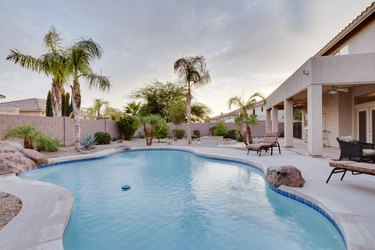
Written by BRYAN TRANDEM and published on https://www.hunker.com/
Regular maintenance is definitely on the to-do list for every pool owner. From balancing the chemicals of the water to vacuuming the surface of the pool, every single maintenance step should be done on a regular basis.
Draining the pool is one of the steps of regular maintenance that you have to keep in mind. But, we’re not talking about weekly, monthly, or even yearly maintenance here. As you may have known, draining a pool takes a lot of elbow grease, and it’s not really that necessary to empty your swimming pool.
When and How To Drain a Swimming Pool

Though it isn’t necessary to frequently drain a pool, draining and refilling the swimming pool is a job most pool owners will face periodically. Most owners will find themselves doing this every four or five years. Although it sounds easy enough, there are several considerations to keep in mind before you open the main drain valve or drop a submersible pump into the deep end of your pool. Before draining your pool, you’ll need a clear idea of why, when, where and how to do it.
Why You Should Drain a Pool
There are a surprising number of people who imagine that a swimming pool should be drained and refilled with fresh water on an annual basis. You might think that doing so is a healthful practice, but annual draining isn’t necessary since modern swimming pools usually have robust filtration systems that keep contaminants in check if you practice good weekly testing procedures. If you regularly check the water chemistry and make adjustments as needed, the filtered water will remain safe to use almost indefinitely. Still, there are times when you will need to drain the water from your pool at least partially:
- When repairs are necessary: All pools will periodically need maintenance repairs, such as patching a torn vinyl liner or repairing cracks or chips to a concrete pool.
- When deep cleaning is needed: Usually, this occurs due to very bad algae conditions, which are often the result of water chemistry that hasn’t been adequately monitored and adjusted. A high algae content in the water can so badly stain the concrete, vinyl or fiberglass shell or liner that the only practical option is to drain the water and scrub the walls of the pool by hand.
- When water chemistry is badly skewed: Over time, the total dissolved solids level in the water can get so far from acceptable that there is no way for the filtration system to return it to optimal levels, or cyanuric acid levels can be too high to be corrected by normal chemistry adjustments. Cyanuric acid levels above 100 to 150 parts per million will usually require draining at least some of the water to start over with fresh water.
- For small above-ground pools in cold-winter climates: Large above-ground pools, like in-ground pools, can usually be covered for the cold winter months without draining. (In fact, it’s usually recommended to keep the water in the pool, though the manufacturer may specify that the filter system should be drained and winterized.) However, some small outdoor pools are designed as portable units that must be folded up and stored each winter. In these circumstances, it is an annual winterizing task to drain the pool entirely each fall before storing the liner.
When to Drain a Pool
When draining a swimming pool becomes necessary, it’s important to do it at the right time. A swimming pool shell is often a fragile structure when empty since the pressure of the surrounding earth can exert considerable force on it. Especially in locations where the water table is high or when the soil is subject to saturation from heavy rain, it’s entirely possible for the hollow shell of your pool to be cracked or even heaved upward out of the ground under the force of the surrounding soil. Even concrete pools can be cracked if the surrounding soil becomes suddenly saturated with water while the pool is empty. For this reason, it’s important to drain your pool at the right time.
- During a period of warm but not hot weather: It’s generally recommended that you drain and complete all maintenance on your pool when temperatures are between 55 and 85 degrees Fahrenheit. It’s also preferable to avoid too much direct sunlight, especially with vinyl or fiberglass pool liners.
- During a dry period: Try to schedule your draining and maintenance during a period when the soil is dry and when no rain is expected. Dry soil will minimize the soil pressure placed on the shell of the swimming pool.
- For as short a time as possible: Drain your pool during a time when you can complete all repairs or maintenance within no more than a few days. Most manufacturers suggest that you not leave an in-ground pool empty for more than a week.
Where to Drain a Pool
Swimming pool water usually contains large quantities of dissolved chlorine and other chemicals, so there are both practical and legal restrictions on where you can drain the water. In most communities, you are required to drain swimming pool water into the municipal sewer system — the same piping system that handles drain water from your indoor sinks, showers and toilets. This is usually done by running a drain hose from the pool’s pump to a floor drain or basement laundry sink, but it is important not to overwhelm the sewer system by pumping too much pool water into it too quickly. Watch the drains carefully as you pump the water to make sure the sewer isn’t backing up.
If the water in your pool is clean and chemically neutral, you may be allowed to drain the water into a storm sewer or onto your lawn. Never run a drain hose into the street unless this method is approved by your local building authorities. Be careful about irrigating your lawn or garden with pool water that has a high level of chlorine in it, as this can damage or kill plants.

How to Drain a Pool
There are several methods for draining a swimming pool, and the best method will depend on the type of swimming pool and the type of filtration system it has. With pools that have vinyl liners, it’s best to avoid draining them completely since the liner can wrinkle, sag or shrink when the pool is completely empty. If you must empty it entirely, do it for as short a period of time as possible. Fiberglass shells can be drained completely but make sure you complete any cleaning or repair tasks within a week.
Concrete pools are usually more stable, but if your pool has hydrostatic relief valves in the bottom or in the drain lines, make sure you open them for the period when the pool will be empty. Should the soil around the pool suddenly become saturated with water, the hydrostatic relief valves will lessen the pressure on the pool structure.
Draining a Pool With the Filter System
Where possible, it’s best to use the pool’s motorized filter system to empty the pool. In normal operation, the pump system returns water to the pool after it flows through the filter cartridge or the sand or diatomaceous earth filtration medium, but when you drain the pool, you will close off the return lines and instead divert the pool water to a drain hose using the valves that are built into the pump for that purpose. Make sure to follow the manufacturer’s instructions for how to use the filtration pump for draining the pool because the procedure differs slightly depending on the style of pump.
With cartridge-filter systems, draining the pool usually involves attaching a drain hose to the drain outlet port on the filtration pump and opening the ball valve that controls it. Then, close the return lines that normally send water back to the pool and/or the skimmer. (Some systems have two return lines: one that returns water directly to the pool and another to the skimmer.) When the filtration pump is turned on, the water is diverted to the drain outlet port rather than back into the pool, and the pool will begin to gradually empty.
Sand or diatomaceous earth filter systems are structured a little differently. They use a backwash feature to periodically clean the filtration medium, and this backwash port can also be used to drain the pool. First, attach a drain hose to the waste outlet on the pump and then set the multiport valve on the pump to the waste setting. Turn the pump on and watch as the pool is slowly emptied of water.
With any filter system, make sure to watch the draining process carefully and shut off the pump before the water is completely drained. It’s important to avoid pumping air through the system, which can damage components. It’s common for there to be 6 to 9 inches of water remaining in the bottom of the pool’s deep end when you turn the pump off. If necessary, the last of this water can be drained using a submersible pump or by bailing it out by hand.
Draining a Pool Using a Submersible Pump
If your pool does not have a filtration pump or if it is not practical to use it to empty the pool, you can do the job with a submersible pump attached to a drain hose. There are some advantages to this method since portable submersible pumps typically pump water at a slower rate than the pool’s filtration pump. This will allow you to control the pace at which you are pumping water into the sewer system.
Attach a drain hose, such as an ordinary garden hose, to the outlet port on the submersible pump and then lower it into the deep end of the pool. Plug the pump into a GFCI-protected electrical outlet to begin the draining process. This can take quite some time, so be prepared to let the pump run for as much as a full day — possibly even overnight — to fully empty the pool. However, make sure the pump does not continue to run when the water level falls below the pump’s intake port, as this can damage the pump’s motor. Some pumps have an automatic shutoff feature to prevent this.

Draining a Pool by Siphoning
With above-ground pools without filters, it is sometimes easiest to drain the pool using the simple principle of siphoning, by which the physics of atmospheric pressure pushes water from higher levels to lower levels through a hose.
First, fill an ordinary garden hose with water. While holding the water in the hose, insert one end of the hose into the pool and then insert the other end into a drain so that this end is lower than the end that is in the pool. Atmospheric pressure will now force the water from the pool down through the drain hose and into the drain.
This process can take quite some time, but that’s one advantage of the method — it allows you to leave the drain hose unattended as the draining progresses. For example, you can leave the siphon drain hose unattended overnight without risk of damaging an electric pump motor.
Original post here hhttps://www.hunker.com/13730714/when-and-how-to-drain-a-swimming-pool/.


